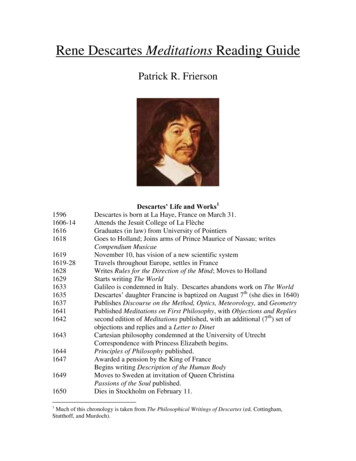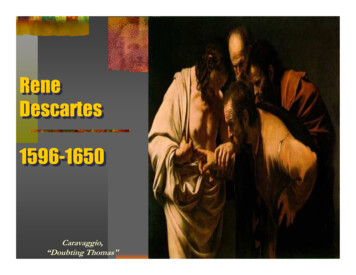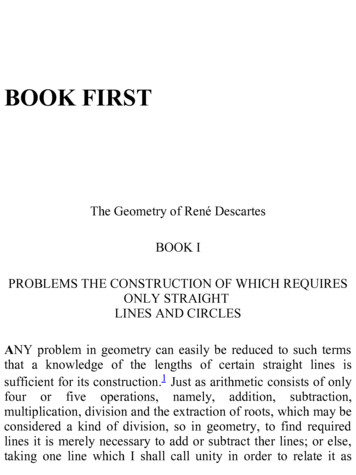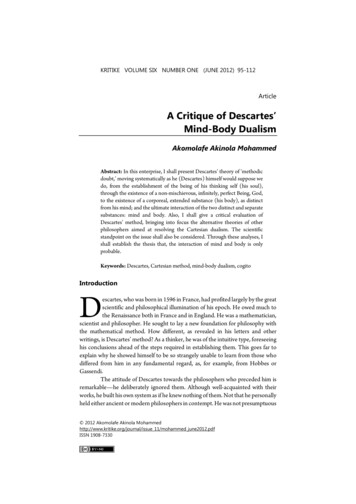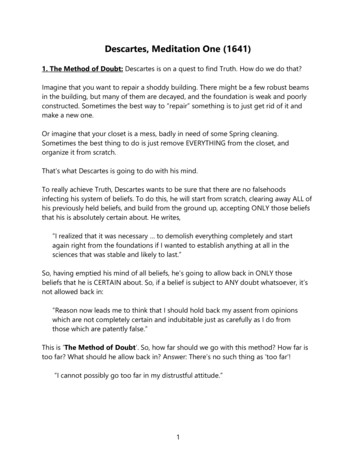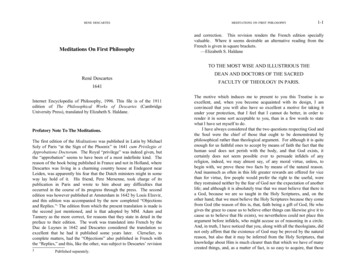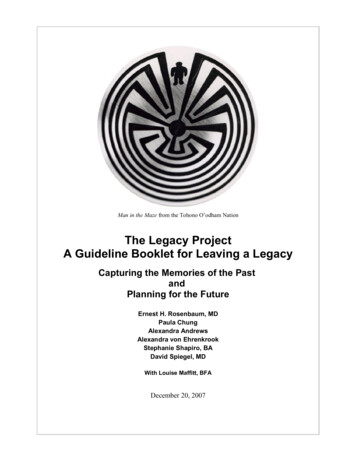
Transcription
Rene Descartes and the Legacy of Mind/Body DualismMIND AND BODY:René Descartes to WilliamJamesbyRobertH.WozniakRENÉ DESCARTES AND THE LEGACY OFMIND/BODY DUALISM1. René Descartes2. The 17th Century: Reaction to the Dualism of Mind and Body3. The 18th Century: Mind, Matter, and Monism4. The 19th Century: Mind and Brain5. Mind, Brain, and Adaptation: the Localization of Cerebral Function6. Trance and Trauma: Functional Nervous Disorders and the Subconscious MindRené Descartes1. René es.html (1 von 4) [08.08.2002 19:08:48]
Rene Descartes and the Legacy of Mind/Body DualismWhile the great philosophical distinction between mind and body in western thoughtcan be traced to the Greeks, it is to the seminal work of René Descartes (1596-1650) [see figure 1], Frenchmathematician, philosopher, and physiologist, that we owe the first systematic account of the mind/body relationship.Descartes was born in Touraine, in the small town of La Haye and educated from the age of eight at the Jesuit college ofLa Flèche. At La Flèche, Descartes formed the habit of spending the morning in bed, engaged in systematic meditation.During his meditations, he was struck by the sharp contrast between the certainty of mathematics and the controversialnature of philosophy, and came to believe that the sciences could be made to yield results as certain as those ofmathematics.From 1612, when he left La Flèche, until 1628, when he settled in Holland, Descartes spent much of his time in travel,contemplation, and correspondence. From 1628 until his ill-fated trip to Sweden in 1649 he remained for the most partin Holland, and it was during this period that he composed a series of works that set the agenda for all later students ofmind and body. The first of these works, De homine [1] was completed in Holland about 1633, on the eve of thecondemnation of Galileo. When Descartes' friend and frequent correspondent, Marin Mersenne, wrote to him ofGalileo's fate at the hands of the Inquisition, Descartes immediately suppressed his own treatise. As a result, the world'sfirst extended essay on physiological psychology was published only well after its author's death.In this work, Descartes proposed a mechanism [see figure 2] for automaticreaction in response to external events. According to his proposal, external motions affect the peripheral ends of thenerve fibrils, which in turn displace the central ends. As the central ends are displaced, the pattern of interfibrillar spaceis rearranged and the flow of animal spirits is thereby directed into the appropriate nerves. It was Descartes' articulationof this mechanism for automatic, differentiated reaction that led to his generally being credited with the founding ofreflex .html (2 von 4) [08.08.2002 19:08:48]
Rene Descartes and the Legacy of Mind/Body DualismAlthough extended discussion of the metaphysical split between mind and body did not appear until Descartes'Meditationes, his De homine outlined these views and provided the first articulation of the mind/body interactionism thatwas to elicit such pronounced reaction from later thinkers. In Descartes' conception, the rational soul, an entity distinctfrom the body and making contact with the body at the pineal gland, might or might not become aware of the differentialoutflow of animal spirits brought about through the rearrangement of the interfibrillar spaces. When such awareness didoccur, however, the result was conscious sensation -- body affecting mind. In turn, in voluntary action, the soul mightitself initiate a differential outflow of animal spirits. Mind, in other words, could also affect body.The year 1641 saw the appearance of Descartes' Meditationes de prima philosophia, in quibus Dei existentia, & animaeà corpore distinctio, demonstraturIn 1649, on the eve of his departure for Stockholm to take up residence as instructor toQueen Christina of Sweden, Descartes sent the manuscript of the last of his great works, Les passions de l'ame[3], topress. Les passions [see figure 3] is Descartes' most important contribution to psychology proper. In addition to ananalysis of primary emotions, it contains Descartes' most extensive account of causal mind/body interactionism and ofthe localization of the soul's contact with the body in the pineal gland. As is well known, Descartes chose the pinealgland because it appeared to him to be the only organ in the brain that was not bilaterally duplicated and because hebelieved, erroneously, that it was uniquely human.In February of 1650, returning in the bitter cold from a session with Queen Christina, who insisted on receiving herinstruction at 5 a.m., Descartes contracted pneumonia. Within a week, the man who had given direction to much of laterphilosophy was dead. By focusing on the problem of true and certain knowledge, Descartes had made epistemology, thequestion of the relationship between mind and world, the starting point of philosophy. By localizing the soul's contactwith body in the pineal gland, Descartes had raised the question of the relationship of mind to the brain and nervoussystem. Yet at the same time, by drawing a radical ontological distinction between body as extended and mind as purethought, Descartes, in search of certitude, had paradoxically created intellectual chaos.ContinueReturn to Table of Contents Forum Guest Exhibitions Serendip Home http://serendip.brynmawr.edu/Mind/Descartes.html (3 von 4) [08.08.2002 19:08:48]
Rene Descartes and the Legacy of Mind/Body DualismSend us your comments at www@serendip.brynmawr.edu by Serendip 1994-2002 - Last Modified: Monday, 02-Dec-1996 09:22:33 l (4 von 4) [08.08.2002 19:08:48]
p://serendip.brynmawr.edu/Mind/Images/01.GIF [08.08.2002 19:09:10]
The 17th CenturyMIND AND BODY:René Descartes to WilliamJamesbyRobertH.Wozniak2. The 17th Century: Reaction to the Dualism of Mind and BodyThe history of philosophizing about the relation of body and mind since Descartes is the history of attempts to escapethe Cartesian impasse. Early maneuvers of this sort, such as those of Malebranche, Spinoza, Leibniz, and the Frenchmaterialists La Mettrie and Cabanis, were formulated in the context of metaphysics, in direct response to Cartesiandualism. Later views which arose in the 19th century needed to reconcile evidence from studies on the localization ofcerebral function and on functional nervous disorders with prevailing theory in biology and psychology. Thesediscussions reflected the newly accepted view that the brain serves as the organ of mind. Although these theories ofmind/brain relations -- epiphenomenalism, interactionism, dual-aspect monism, and mind-stuff theory -- wereformulated in the context of science, they too were oriented toward circumventing the Cartesian impasse.If the natural world is radically divided into the mental and the physical such that thephysical is extended in space and the mental is not, and if the nature of causality is such that causes and effects musthttp://serendip.brynmawr.edu/Mind/17th.html (1 von 3) [08.08.2002 19:09:22]
The 17th Centuryhave a necessary connection and be of a similar type, then mind/body interactionism of the Cartesian sort is obviouslyuntenable. Perhaps the first important attempt to deal with this contradiction in Descartes is that known asoccasionalism. Although preceded and influenced by Le discernement du corps et de l'ame (1666) of Géraud deCordemoy (d. 1684), the work of Nicolas Malebranche (1638-1715) was probably the most influential purveyor ofoccasionalism.Born in Paris and educated at the Collège de La Marche and the Sorbonne, Malebranche began to read Descartes in1664. A decade later, he published De la recherche de la vérité[4,see figure 4] in which he argued that both ofDescartes' substances, mind and body, are causally ineffective. God is the one and only true cause. Not only is there noinfluence of mind on body or of body on mind, there is no causality operative at all except insofar as God, the one truecause, intervenes to produce the regularities that occur in experience. Thus, for example, when a person wills to move afinger, that serves as the occasion for God to move the finger; when an object suddenly appears in a person's field ofview, that serves as the occasion for God to produce a visual perception in the person's mind.An alternative and much more enduring attempt to respond to the Cartesian impasse wasthat of Benedictus de Spinoza (1632-1677) [see figure 5]. Born in Amsterdam, Spinoza spent his life as a lens grinder. AJew who had been expelled from the synagogue for unorthodoxy, he maintained few ties to either Dutch or Jewishcontemporaries and published little during his lifetime. The metaphysical masterpiece,De ethica, appeared in his Operaposthuma[5], first published in 1677.In order to retain the notion of God as the one true cause without sacrificing the idea of causality as operative in both themental and the physical spheres, Spinoza abandoned Descartes' two-substance view in favor of what has come to becalled double-aspect theory. Double-aspect theories are based on the notion that the mental and the physical are simplydifferent aspects of one and the same substance. For Spinoza, that single substance was God. While agreeing withDescartes that the world of consciousness and that of extension are qualitatively separate, Spinoza rejected the Cartesianview that consciousness and extension are attributes of two finite substances in favor of the notion that they areattributes of only one infinite substance. That substance, God, is the universal essence or nature of everything that exists.The direct implication of Spinoza's view is that while mental occurrences can determine only other mental occurrencesand physical motions can determine only other physical motions, mind and body nonetheless exist in pre-establishedcoordination, since the same divine essence forms the connections within both classes and cannot be self-contradictory.In the later half of the 19th century, as we shall see, dual-aspect theories underwent a revival.Still another alternative to Cartesian interactionism is that of psychophysical parallelism. This view retains both thedualism of mind and body and the notion of a regular correlation between mental and physical events, but avoids anyassumption of causal mind/body connection, direct or indirect. Psychophysical parallelism eschews interactionism onthe grounds that events so totally dissimilar as those of mind and body could not possibly affect one another. It alsorejects occasionalism and dual-aspect theory on the grounds that no third entity, whatever that might be, could beresponsible for such vastly different effects. Parallelists simply accept the fact that every mental event is correlated withhttp://serendip.brynmawr.edu/Mind/17th.html (2 von 3) [08.08.2002 19:09:22]
The 17th Centurya physical event in such a way that when one occurs, so too does the other.Parallelism in this form is usually traced to Gottfried Wilhelm Leibniz (1646-1716). Historian, mathematician,philosopher, scientist, and diplomat, Leibniz was born and received most of his education in Leipzig. In 1676, after aperiod at Mainz and four years at Paris, he went to Hanover, where he spent the remainder of his life. An inveteratecorrespondent, contributor to scholarly journals, and creator of manuscripts, much of Leibniz' most important work wasembodied in letters, published in article form, or left unpublished at his death.In the Système nouveau de la nature (1695) and the Eclaircissement du nouveau sisteme (1696), Leibniz presented thefamous articulation of psychophysical parallelism in which he adapted an occasionalist metaphor to support the viewthat soul and body exist in a pre-established harmony. Comparing soul and body to two clocks that agree perfectly,Leibniz argued that there are only three possible sources for this agreement. It may occur through mutual influence(interactionism), through the efforts of a skilled workman who regulates the clocks and keeps them in accord(occasionalism), or by virtue of the fact that they have been so constructed from the outset that their future harmony isassured (parallelism). Leibniz rejects interactionism because it is impossible to conceive of material particles passingfrom one substance to the other and occasionalism as invoking the intervention of a Deus ex machina in a natural seriesof events. All that remains is parallelism -- the notion that mind and body exist in a harmony that has been preestablished by God from the moment of creation.ContinueReturn to Table of Contents Forum Guest Exhibitions Serendip Home Send us your comments at www@serendip.brynmawr.edu by Serendip 1994-2002 - Last Modified: Tuesday, 03-Sep-1996 16:19:01 EDThttp://serendip.brynmawr.edu/Mind/17th.html (3 von 3) [08.08.2002 19:09:22]
Mind and BodyMIND AND BODY:René Descartes to WilliamJamesbyRobertH.WozniakModified from the Catalogue Accompanying an Exhibition of Books from the Collections of the National Library ofMedicine, Held in Honor of the Centennial Celebration of the American Psychological Association, August 7 toDecember 15, 1992The original exhibition was sponsored by National Library of Medicine, Bethesda, Maryland; and the AmericanPsychological Association, Washington D.C. 1992A translation into Spanish has been prepared and made available by Miguel Angel de la Cruz Vives.http://serendip.brynmawr.edu/Mind/ (1 von 2) [08.08.2002 19:09:30]
Mind and BodyAcknowledgementsTABLE OF CONTENTS IntroductionI. RENÉ DESCARTES AND THE LEGACY OF MIND/BODY DUALISM1. René Descartes2. The 17th Century: Reaction to the Dualism of Mind and Body3. The 18th Century: Mind, Matter, and Monism4. The 19th Century: Mind and Brain5. Mind, Brain, and Adaptation: the Localization of Cerebral Function6. Trance and Trauma: Functional Nervous Disorders and the Subconscious MindII. THE RISE OF EXPERIMENTAL PSYCHOLOGY1. The 17th and 18th Centuries: The Epistemology of Mind2. The 19th Century: The Epistemology of the Nervous System3. Mind, Brain, and the Experimental Psychology of ConsciousnessIII. PSYCHOLOGY IN AMERICA1. Mind, Body, and Culture: American Psychology before William James2. Biological Consciousness and the Experience of the Transcendent: William James and AmericanFunctional Psychology[By Eugene Taylor, Harvard University Medical School]CATALOGUE OF THE EXHIBITREFERENCES AND TITLES CONSULTED Forum Guest Exhibitions Serendip Home Send us your comments at www@serendip.brynmawr.edu by Serendip 1994-2002 - Last Modified: Thursday, 15-Mar-2001 16:00:10 ESThttp://serendip.brynmawr.edu/Mind/ (2 von 2) [08.08.2002 19:09:30]
The 18th CenturyMIND AND BODY:René Descartes to WilliamJamesbyRobertH.Wozniak3. The 18th Century: Mind, Matter, and MonismAll of the above views, even that of Spinoza, make some distinction between mind andbody. Once such a distinction is drawn, at whatever level, the problem of re-relating mind to body immediately arises. Inorder to avoid the mind/body problem entirely, one must deny any distinction between mind and body. Over the courseof intellectual history, denials of this sort have taken different forms. Immaterialism, best represented by GeorgeBerkeley (1685-1753) in his A Treatise concerning the Principles of Human Knowledge (1710), denies even thepossibility of mindless material substance. For something to exist for Berkeley, it must either be perceived or be theactive mind doing the perceiving. From this perspective, there is no mind/body distinction because what we think of asbody is merely the perception of mind. While Berkeley had few contemporary adherents, immaterialism was toresurface in the later 19th century in the guise of mind- stuff theory.Materialism, which dates to antiquity, holds that matter is fundamental. Whatever else may exist, if it exists, it dependson matter. In its most extreme version, materialism completely denies the existence of mental events, a view whichwould appear to have its roots in Descartes' conception of animals as purely physical automata. In a less extreme form,materialism makes mental events causally dependent on bodily events, but does not deny their existence. This was thehttp://serendip.brynmawr.edu/Mind/18th.html (1 von 3) [08.08.2002 19:09:52]
The 18th Centuryview offered a century after Descartes by Julien Offray de la Mettrie (1709-1751) [see figure 6].La Mettrie was born in Brittany, in the town of Saint-Malo. After studying medicine atParis and Rheims, he worked under Hermann Boerhaave at Leiden. In 1745, he published his first work, Histoirenaturelle de l'ame. Public outcry over his materialism, exacerbated by outrage over his publication of an incautiousmedical satire, led to La Mettrie's self-exile to Holland. There, in 1748, he published L'homme machine[6], an extensionof Descartes' automata concept from animals to man. With L'homme machine, La Mettrie succeeded in testing thepatience of even the liberal Dutch clergy. The book was publicly burned [see figure 7] and La Mettrie was forced to seekprotection from Frederick the Great at Berlin. There, until his death in 1751, he continued to publish on a variety oftopics, usually in a manner calculated to infuriate his enemies.In many ways, L'homme machine was a ground-breaking work. While arguing the case for a uniform materialdependence of states of the soul upon states of the body, it maintained a distinctly antimetaphysical tone. As Vartanian(1967) pointed out, La Mettrie's "naturalistic view of man . is offered mainly as a general heuristic hypothesisnecessary in the positive study of behavior, without the need being felt . to make mental processes reductively identicalwith their physiological causes" (p. 380). In addition, L'homme machine introduced the critical notion that conscious andvoluntary processes are only distinguished from involuntary and instinctual activities by the relative complexity of theirmechanical substrate. In articulating this point, La Mettrie went far beyond the static mechanism of Descartes toconceive of the living machine as a purposive, autonomous, and dynamic system.http://serendip.brynmawr.edu/Mind/18th.html (2 von 3) [08.08.2002 19:09:52]
The 18th CenturyAlthough vilified in his own time, La Mettrie's often unacknowledged influencecontinued to be felt for many years within French intellectual circles. Pierre Jean Georges Cabanis (1757-1808) [seefigure 8] was among those indebted to La Mettrie's ideas. Indeed, Cabanis, the most ardent materialist of the Frenchenlightenment, was simply taking La Mettrie's naturalism to its logical extreme in his Rapports du physique et du moralde l'homme (1802) [7], when he argued that "to have an accurate idea of the operations from which thought results, it isnecessary to consider the brain as a special organ designed especially to produce it, as the stomach and the intestines aredesigned to operate the digestion, (and) the liver to filter bile." (English translation, p. 116)ContinueReturn to Table of Contents Forum Guest Exhibitions Serendip Home Send us your comments at www@serendip.brynmawr.edu by Serendip 1994-2002 - Last Modified: Tuesday, 03-Sep-1996 16:26:52 EDThttp://serendip.brynmawr.edu/Mind/18th.html (3 von 3) [08.08.2002 19:09:52]
The 19th CenturyMIND AND BODY:René Descartes to WilliamJamesbyRobertH.Wozniak4. The 19th Century: Mind and BrainAs the 19th century progressed, the problem of the relationship of mind to brain became ever more pressing. Indeed, sodeep was the concern with mind/brain relations that it is difficult to find a systematic text written after 1860 that doesnot contain a discussion of this issue. To a large extent, this directly reflected two major developments that converged toimpress philosophers and psychologists with the centrality of the mind/brain problem. The first of these involvedprogress in understanding the localization of cerebral function, based on the idea that the brain serves as the organ ofmind. The second involved a growing familiarity with the thesis that mental events -- beliefs, mental suggestions,mesmeric trance states, psychic traumas and the like -- sometimes bring about radical alterations in the state of the body.This change occurred as progress was made in understanding the nature of functional nervous disorders. Beforeproceeding further, we will briefly describe some of the major mind/brain perspectives articulated in response to thesetrends.Although the theories of mind/brain relationship prevalent in the 19th century -- epiphenomenalism, interactionism, dualaspect monism, and mind- stuff -- were formulated in the context of science, they, like their predecessors, were attemptsto deal with the metaphysical complexities of the Cartesian impasse. It is not surprising, therefore, that these viewsevolved for the most part as variations on themes already tml (1 von 6) [08.08.2002 19:10:04]
The 19th CenturyIn 1870, Shadworth Holloway Hodgson (1832-1912), an English philosopher, published atwo-volume work entitled The Theory of Practice [8]. In it he provided the first modern articulation of a view that hetermed epiphenomenalism. Descartes, of course, had conceived the idea that animals were purely physical automatadevoid of mental states, a notion that carries with it the implication that a completely self-sufficient neural mechanismcan produce complicated and apparently intelligent acts. In La Mettrie and, later, in Cabanis, this view was extended tohumans, but moderated so that only the causal efficacy and not the actual existence of mental states was denied. In thisregard, the French materialists anticipated Hodgson.In The Theory of Practice [see figure 9], Hodgson argued that, regardless of their intensity, feelings have no causalefficacy whatsoever. Comparing mental states to the colors laid on the surface of a stone mosaic and neural events to thesupporting stones, Hodgson asserted that just as the stones are held in place by one another and not by the colors theysupport, events in the nervous system form an autonomous chain independent of accompanying mental states. Mentalstates are present only as "epiphenomena," incapable of reflecting back to affect the nervous system.This view was subsequently taken up, popularized, and placed within an evolutionary framework by Thomas HenryHuxley (1825-1895). In 1874, in an address in Belfast to the British Association for the Advancement of Science,Huxley presented one of the most widely cited and influential papers of the period, "On the hypothesis that animals areautomata, and its history." In it Huxley suggested that states of consciousness are merely the effect of molecular changesin brain substance that has attained a prerequisite degree of organization. Animals, therefore, are "conscious automata."In the same year, another work appeared, Principles of Mental Physiology [9] byWilliam Benjamin Carpenter (1813-1885) [see figure 10], which took a position on the mind/brain relation h.html (2 von 6) [08.08.2002 19:10:04]
The 19th Centuryopposed to the epiphenomenalism of Hodgson and Huxley. Carpenter was a British physician who had received hismedical education at Bristol, University College London, and Edinburgh. In 1845 he assumed the FullerianProfessorship of Physiology at the Royal Institution and from 1856 to 1879 served as Registrar at the University ofLondon. Principles of Mental Physiology contained as thoroughgoing an interactionism as the 19th century produced:"Nothing," Carpenter wrote, "can be more certain, than that the primary form of mental activity, -- Sensationalconsciousness, -- is excited through physiological instrumentality. A certain Physical impression is made, for example,by the formation of a luminous image upon the Retina of the Eye . Light excites Nerve-force, and the transmission ofthis Nerve-force excites the activity of that part of the Brain which is the instrument of our Visual Consciousness. Nowin what way the physical change thus excited in the Sensorium is translated (so to speak) into that psychical changewhich we call seeing the object whose image was formed upon our Retina, we know nothing whatever; but we areequally ignorant of the way in which Light produces Chemical change . And all we can say is, that there is just as closea succession of sequences -- as intimate a causal relation between antecedent and consequent -- in the one case, as thereis in the other."Conversely, "the like Correlation may be shown to exist between Mental states and the form of Nerve-force which callsforth Motion through the Muscular apparatus . each kind of Mental activity, -- Sensational, Instinctive, Emotional,Ideational, and Volitional, -- may express itself in Bodily movement . Just as a perfectly constructed Galvanic battery isinactive while the circuit is "interrupted," but becomes active the instant that the circuit is "closed," so does a Sensation,an Instinctive tendency, an Emotion, an Idea, or a Volition, which attains an intensity adequate to "close" the circuit,liberate the Nerve-force with which a certain part of the Brain . is always charged" (pp. 12-14).Unfortunately, in the 241 years separating Descartes' De homine from Carpenter's Principles of Mental Physiology, littleprogress had been made in removing the primary objection to interactionism. In the oft quoted words of John Tyndall(1871), "the passage from the physics of the brain to the corresponding facts of consciousness is unthinkable. Grantedthat a definite thought, and a definite molecular action in the brain occur simultaneously; we do not possess theintellectual organ, nor apparently any rudiment of the organ, which would enable us to pass, by a process of reasoning,from the one to the other" (pp. 119-120). Since this is an objection that can be just as effectively urged againstepiphenomenalism, which rids itself of only half the problem of interactionism, other 19th century thinkers turned, ashad their predecessors, to monism as the view of last resort. Two of the most influential monisms of the period, bothaspect theories, were dual-aspect monism and mind-stuff theory.Dual-aspect monism was the brain child of George Henry Lewes (1817- 1878). Born in London, Lewes was one of themost versatile and brilliant minds of the century. A writer, actor, biologist, philosopher, and psychologist, his interestsranged across a staggering array of topics. He was the author of a still widely read Biographical History of Philosophy(1845/1846). His Physiology of Common Life (1859/1860) converted the young Pavlov to the study of physiology, andhis five-volume Problems of Life and Mind (1874/1879) constituted a major contribution to the psychology of theperiod.In The Physical Basis of Mind [10], which forms the third volume of Problems of Life and Mind, Lewes articulated theclassic modern formulation of double aspect theory, dual-aspect monism. In presenting his position, Lewes went wellbeyond the theories of his predecessors, supplementing the double aspect notion with a view that has come to be calledneutral monism. Neutral monism involves the claim that there is only one kind of "stuff" and that mind and body differonly in the arrangement of that stuff or in the perspective from which it is apprehended.Borrowing a metaphor from Fechner, Lewes characterized the relation of mind to body as a curve that maintains itsidentity as a single line even though characterized at every point by both concavity and convexity. Mental and physicalprocesses, in other words, are simply different aspects of one and the same series of psychophysical events. When seenfrom the subjective point of view (e.g., when someone is thinking), the psychophysical series is mental; when seen fromthe objective point of view (e.g., when someone observes what is going on in the thinking person's brain), it is physical.In the argument for the dual-aspect view, however, Lewes's innovation was by no means restricted to his neutralmonism. Mental and physical descriptions, he went on to assert, employ terms which are not intertranslatable. The visualhttp://serendip.brynmawr.edu/Mind/19th.html (3 von 6) [08.08.2002 19:10:04]
The 19th Centuryexperience of a large elephant can not be adequately described through statements that characterize either the laws oflight or the mechanisms of the nervous system. Mental terms, in other words, cannot in principle be replaced by physicalterms. In making this claim, Lewes transferred the domain of discourse from metaphysics to language and providedwhat is still the best argument against extreme reductionism and the replacement of psychology by physiology.Mind-stuff theory, which is logically akin toLewes's dual-aspect monism, involves a number of related ideas. The first of these is that higher properties of mind,such as judgment, reasoning, volition, or the continuous flow of consciousness, are compounded from mental elements(pieces of mind-stuff) that do not in themselves manifest these higher properties. The second is that even the most basicmaterial elements possess a small piece of mind-stuff such that when these elements are combined, mind-stuff issimilarly combined. Thus, for example, when molecules come together at a level of complexity sufficient to form a brainand nervous system, correlative mind-stuff forms consciousness. And finally, in contrast to the dual-aspect monism ofLewes, which construes both mind and matter as aspects of a neutral substance, mind-stuff theory takes a position ofpsychical monism, arguing that mind is the only actual substance and that the material world is nothing more than a
dualism of mind and body and the notion of a regular correlation between mental and physical events, but avoids any assumption of causal mind/body connection, direct or indirect. Psychophysical parallelism eschews interactionism on the grounds that events so totally dissimilar as those of mind and body could not possibly affect one another. It also

